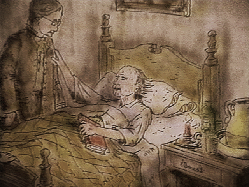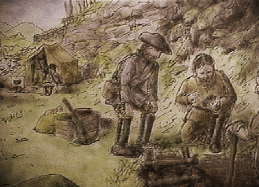Blind Spot: Swift's Lost Silver Mine and Dorr's River of Gold
In our last installment, Joseph Mulhatton: Liar Laureate of the World, I took listeners deep into the history of fake news by exploring the life and work of the most prolific newspaper hoaxer who ever lived. The subject of that episode was first introduced to me while listening to the hugely entertaining and informative podcast Astonishing Legends, as hosts Forrest Burgess and Scott Philbrook brought up Mulhatton as a possible explanation for the newspaper article that sparked the legend of Kinkaid’s Cave in the Grand Canyon. This story in the Arizona Gazette in 1909 indicated that a massive cavern had been found in the Grand Canyon that contained not only treasures but also relics and mummified remains that indicated it had once been the home of an Egyptian civilization, thus providing evidence of pre-Columbian trans-oceanic contact. The guys at Astonishing Legends rightly pointed to a quite convincing theory by Don Lago, published by the Grand Canyon Historical Society, that this was a Mulhatton hoax. And indeed, listeners should find many aspects of the Kinkaid’s Cave tale familiar, as Mulhatton several times published hoaxes about caverns with underground rivers and great riches, including proof of pre-Columbian, specifically Egyptian, contact. Philbrook and Burgess of Astonishing Legends also cautioned, however, that there is no proof of Mulhatton having perpetrated this story as a hoax, and it should be kept in mind that there is a long history, both before and after Mulhatton’s time, of stories about caves containing riches untold, legends that spread far and wide and persist even today, despite the fact that they may be nothing more than fables and tall tales. One only has to look at two such American legends to see this folkloric tradition: Swift’s Lost Silver Mine and Dorr’s River of Gold.
*
The first of these tales finds us back in Mulhattan’s stomping grounds, Kentucky, but in the late 18th century. A pioneer by the name of Dooley Townsend is out one day setting traps by the Red River when a band of lost and starving men come upon him, desperate for sustenance and direction. Townsend helps them, but one man among them, an old blind man, is far too gone and dies with Townsend at his bedside, bequeathing to the Good Samaritan his only possession of value, a journal. And the story this journal tells will establish a legend that will drive many to adventure and ruin.
Swift bequeathing his journal, via rootsweb.ancestry.com
According to the journal, the old man was one John Swift, formerly a seagoing man and ship captain who may have commanded any sort of vessel, from merchantman to pirate ship, as far as the record tells. Having retired from that life to become a merchant in North Carolina and Virginia, he happened to take under his wing a young man named Munday who had lived most of his life among Native American tribes. Out of gratitude, Munday promised to lead Swift to a secret cave in Kentucky where native peoples were known to mine silver. So off they went, in the early 1760s, to find the mine, forging through the untamed wilderness that was Kentucky long before Daniel Boone was ever reported to have done so and never encountering a single Native American, as it appears, at least according to some historians, that no tribes then lived in the region, instead using the land only to hunt and meet in open warfare.
Eventually, Munday found the old mine, which was essentially a cave in the face of a cliff, and Swift’s journal gave very precise descriptions of landmarks leading to the mine, ostensibly as a record so that Swift could find it again. He found the mine plentiful indeed, reporting that he easily found ore and was even able to smelt it in a nearby stone furnace. Therefore, he and Munday returned to the mine several times throughout the 1760s, until once they stayed too long, despite Munday’s warnings, and were beset by Native American warriors, barely escaping with their lives. After that close call, they did not return for several years, and when they did, they came prepared to haul back as much silver as possible. On their way back, each member of their party rode his horse with a large, heavy sack of silver, such that the horses could not carry any more weight, but a snake bit Munday’s horse, killing it. When Munday suggested that others go on foot as well so that he could place his sack on a horse and not have to leave it behind, an argument ensued. During the quarrel, Munday threatened to betray the group to area natives, and Swift murdered him.
Swift and Munday searching for the mine, via rootsweb.ancestry.com
Some versions of his story have Swift going back to England after this, where he was imprisoned on some crime. Others have him returning to North Carolina, where his spending of silver coins he had minted himself got him tried for counterfeiting, charges that were supposedly dismissed when the coins were found to be pure silver. Regardless of where he was in the interim, one detail is agreed upon; not suddenly but inexorably, Swift went blind, and thereafter, all of his future expeditions relied on his recollections, comparing his descriptions to the observations of his travelling companions. Thus his last expedition, when Townsend discovered him lost in the wilderness and starving. After Dooley Townsend received the journal, it was thereafter lost, perhaps taken from his belongings upon his death by an unscrupulous lawyer. Word of its existence first appears in the historical record in 1788, and ever since, it has become a mythical artifact, its narrative and maps passing from treasure hunter to treasure hunter, and somewhere along the way becoming duplicated and bastardized by forgers and compilers claiming to reproduce it from memory, such that there appear to have been multiple competing versions in circulation, all claiming authenticity even though some bear the clear marks of paraphrasing and even bald-faced quotation!
While some argue over the particulars of what has been recorded from these different documents, others dispute the entire story outright. Believers point to Kentucky place names and oral history as proof that Swift and his mine existed, while the more scholarly pore over old documents in search of his name and cite a 1788 treasury warrant by Kentucky historian and mapmaker John Filson as evidence for the story’s veracity, as the warrant identifies 1,000 acres that were supposed to contain Swift’s mine. For proof that Swift’s silver coins did and do exist, numismatists, or coin collectors, will point to the Sprinkle Dollar, a silver coin of unknown origin supposed to have turned up in circulation in 1830s West Virginia.
A map supposedly based on details from Swift's journal, via TreasureNet
On the other hand, skeptics pick apart all documentary evidence by pointing out inconsistencies and look to geological evidence that Kentucky sandstone has never produced more than trace amounts of silver, and nothing like the great veins and nuggets reported in the Swift tales. Some say that Swift concocted the tale as a cover for counterfeiting activity and piracy, kind of like money laundering in that he had to offer some explanation for ill-gotten coinage, but other disbelievers take it further and allege that Swift himself never existed. One theory points to the many Masonic symbols in the surviving accounts of the Swift journal to suggest it was written as an allegory, symbolically representing Masonic ideas of the search for enlightenment and tying into tales of Solomon’s mines. These theories tend to point at none other than the historian John Filson, he who first put down a reference to the mine for history and posterity, as the perpetrator of this literary hoax.
Whether the story of Swift’s Lost Silver Mine was a hoax or a literary concoction or a genuine lost treasure, it has certainly driven many a seeker of wealth and adventure to devote their lives and fortunes to searching for it. And even today, well into the 21st century, treasure hunters expend great effort and capital in searching for the lost mine.
Portrait of Earl Dorr, via The Mojave Project
Such is also the case with another legend that sounds even more like a Mulhatton tall tale, featuring as it does a vast subterranean river, although this one appeared decades after the Liar Laureate’s alleged passing. In 1934, a prospector named Earl P. Dorr swore an affidavit regarding the discovery of a cavern and underground river beneath Kokoweef Mountain in the Joshua Tree region of the Mojave Desert. His story unfolded as follows: Three Native American brothers, the Peyserts, had been hired to work on his father’s ranch in the 1890s. During the first few years of the 20th century, the brothers went in search of the motherlode that tribal legend told was secreted beneath Kokoweef, and find it they did. After discovering the entrance to a vast cavern system and exploring its labrynthine passages, they came upon a chamber where an underground river lapped against virgin black sands sparkling with placer gold. The Peyserts took what they could, but before they left, the waters rose as in a sudden tidal influx and drowned one of them. Out of superstition, they never returned to the cavern that had claimed their brother’s life, but they did tell Earl Dorr of the cavern and the river of gold, and Dorr’s affidavit claimed he had gone on to find it, but after the cavern’s entrance was seen by two other prospectors, he blasted it to keep them from taking the gold for themselves, and after that he was unsuccessful at finding another entrance.
The Peyserts making their discovery, in The Desert Magazine, via The Mojave Project
Disbelievers in Dorr’s story call him a teller of tales, suggesting that he may have explored an actual, verified cave beneath Kokoweef, called Crystal Cavern, but that his tales of finding treasure there were fabrications. As proof they point to the fact that he actually swore out multiple affidavits, and that the details between them create discrepancies. Moreover, it appears that many particulars of his story, including the Native American brothers’ discovery of the cave, the description of the underground river and black sands laden with gold, and the tidal waters claiming one brother’s life, were likely plagiarized from a collection of mythical yarns about lost mines and buried treasure written by one John Mitchell and published a year before the swearing out of his affidavits under the title Lost Mines of the Great Southwest. Nevertheless, these revelations have not deterred believers, and the legend has persisted. In the early 90’s, the story of Earl Dorr’s River of Gold was even featured on the classic show Unsolved Mysteries. In the segment, which can be seen on Amazon Video on episode 4 of season 6, Robert Stack tells the story of one Wally Spencer, who claimed to have found Dorr’s river and believed the government was conspiring against him, bugging his house to find the river’s location and take the water rights for themselves. Even today there exists a mining operation at Kokoweef Mountain that has sworn to its shareholders for years that they were very near striking the mountain’s legendary mother lode.
Earl Dorr at his River of Gold, from The Desert Magazine, via The Mojave Project
These stories of lost treasure made their way not only into history books in some cases, but perhaps more profoundly, they established themselves in popular belief and have obsessed treasure hunters and adventurers for decades and even centuries. When stories such as these, the veracity of which are vehemently debated, can become the sole focus and pursuit of people’s lives, then the relatively common and more often than not harmless condition of historical blindness becomes injurious and takes on a more fearsome aspect. Whether hoaxes like Mulhatton’s or earnest reports of riches real or imagined, these blind spots in history have lured many seekers to ruin.






























